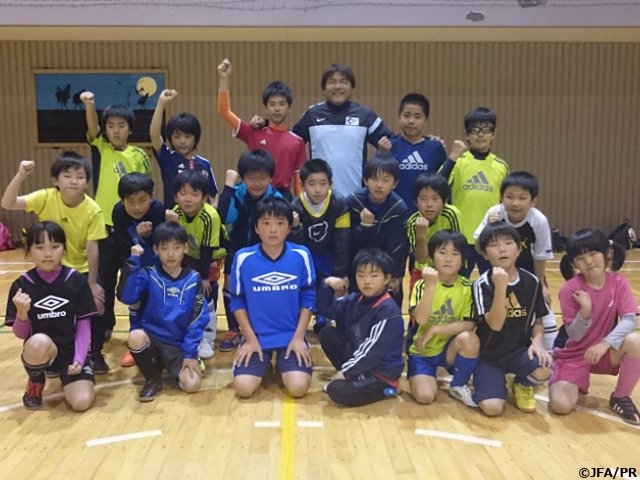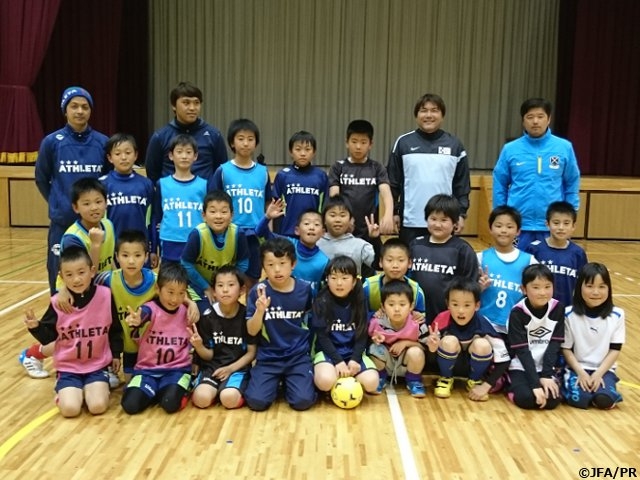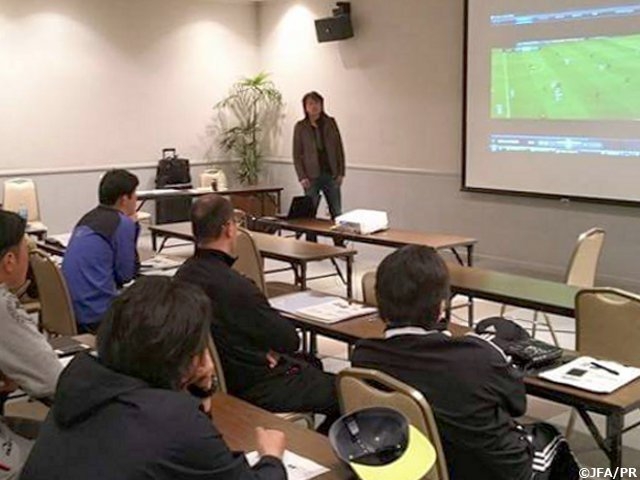NEWS
JFA Tohoku Reconstruction Support Project - April 2015 Report by TEGURAMORI Hiroshi, national training centre coach
14 May 2015

I visited Sendai in Miyagi prefecture on 15 April. Since Sendai is capital city of Miyagi, many people may think its reconstruction is complete, but there are people who still have to stay in temporary housing in coast area where it is a 20-30 minute drive from central Sendai.
Kaihin Park in Wakabayashi, in Sendai, used to be a football match venue, but it has been shut due to the Tsunami. Nipperia Ground in Wakabayashi, and Ogimachi Yon-chome Park in Miyanogi have been used for temporary housing hence they are not available as a football venue. Here, it is difficult to get official match venues and one of the matches whose name is “Tanabata Cup”, which is usually held in or around July, had to take place at a different time of year and in another local area because of this lack of area to play football.
In Wakabayashi, there are only two venues available for matches, Furujiro Elementary School and Okino Elementary School, and each of them have only one smaller pitch. Shichigo Elementary School in Wakabayashi used to have spacious ground with lighting facility, but it is not available since there are temporary classrooms to accept students from other schools where were damaged by Tsunami. From this April, a neighboring Kabanomachi Elementary School has finally reopened and the temporary classrooms in the ground of Shichigo Elementary School will be removed. It is expected to use the football ground from this September or October.
On the same day, I had a chance to watch a training of Yuriage Kids Sports Club, in Natori. Twenty players joined in the training and I led sessions such as “passing & controlling”, and “1+2 -on-2 ball possession” for 1 hour. The kids players were very active in these sessions.
The next day I visited was on 16 April, I joined in the training of Arahama Junior in Watari. Currently, Watari Athletic Ground is not available due to turf preparation and the team had to change the training venue to the gymnasium of Arahama Elementary School. Twenty three U-12 players joined in several sessions such as “Passing & Controlling”. I added some restrictions in this session such as directive limit in passing, and in which the foot they could use to control the ball to keep ball possession at a 4-on-1 session. At the end of training, they were divided in to 2 age groups and had mini-matches. They played very aggressively in the matches.
Kikuchi, head coach of the team told me that there was a popular accommodation facility with hot spring in Arahama, and many people including tourists and student campers used to visit there before the Great East Japan Earthquake. After the earthquake, they restored this facility to accept visitors and a local shopping street “Nigiwai Kairo” with 6 shops has recently opened. Reconstruction of this area has been gradually moved on with the opening of a local market, fishing facility, and strawberry farm.
Local breakwater construction project has been completed and now other projects especially for road improvement and raising ground heights. Kikuchi said “We want our area to be back to how it used to be before the earthquake as soon as possible; for that, our local athletic ground and tourist accommodations need to be reconstructed soon.”

On 18 April, I visited SK-SC Kids Sports Club training. The club has about 60 U-12 players and I saw they have good training with several trainers according to categories. Their ground is not big enough, but they maximised the limited space to have effective training sessions. I enjoyed some sessions with the eldest group players. MIYAGI Hideo, Representative of the team requested our support for goal posts. Considering there will be more football grounds will be reconstructed in the future, there would be more requests for goal post support. We would like to respond to them as much as possible.
As I mentioned before, Kaihin Park in Wakabayashi has been shut due to the Tsunami and there isn’t any alternative place for this facility yet. There are housing plans around the mentioned Kabanomachi Elementary School and Shitigo Elementary School and both schools are expected to have more than 1,000 students in the future; it will be more than their current number of pupils which Shichigo has 1,000 and Kabanomachi school has 600.
Mr. Miyagi has concerns about a lack of training venues for any sports in the future caused by increasing number of children without expansion of training space in their local area. “I’m sorry for the kids who can’t have enough space. Kabanomachi Elementary School ground will open in September or October which I think is very precious, but we still struggle with less sports facility to hold official matches here. We really want local reconstruction”, said Mr. Miyagi.
On 19th, Sennan Regional League opened, and the mentioned Arahama Junior has got 1 win and 1 loss so far. I had a good chance to watch the team’s victory at their match.
On 25-26 April, I participated in the meeting about Training Centre Reconstruction in Fukushima with Mr. YAMAZAKI Shigeo, Tohoku Youth Director and Mr. KATO Kenji, National Training Centre Coach. Mr. Ito the Leader of this committee said “Thank you very much for all the continuous support such as the coaching and lecturing National Training Centre coaches and players. We still depend on your support by getting the directions. We want to keep working to improve ourselves so that we can take more initiatives to train our players in the future. We Fukushima people need to change through taking your support. ”
Reconstruction Training Centre’s aim is sustainability for the future; we want to encourage the local players and trainers to improve themselves on their own in the future. Throughout this opportunity, I had meetings with Ito, Chairman of Class 4 Technical Committee in Fukushima Football Association, and other leaders in Fukushima. I also had discussion about 2014 annual review and issues for the future especially with Training Centre coaches. In these meetings, there were some requests for us such as continuous support to hold a kid’s football event, Girl’s Training Centre, Class 3 Training Centre, and Coach training including lectures. We would be happy to respond to these requests from them.
YAMAZAKI had lectures in this 2-day meeting and he strengthened “Change JAPAN’S WAY” to win the FIFA World Cup in the future and that helped all of participants to understand the importance of grass-roots football activities.
We will do our best “putting players first” to improve football in Fukushima!

Related News
-
2015/04/08
JFA Tohoku Reconstruction Support Project - March 2015 Report by TEGURAMORI Hiroshi, national training centre coach

-
2015/03/24
JFA Tohoku Reconstruction Support Project - February 2015 report by TEGURAMORI Hiroshi, national training centre coach

-
2015/03/06
JFA Tohoku Reconstruction Support Project - January 2015 Report by TEGURAMORI Hiroshi, national training centre coach

-
2015/01/16
JFA Tohoku Reconstruction Support Project - December 2014 Report by TEGURAMORI Hiroshi, national training centre coach

Latest News
-
National Teams
2025/12/15
Japan Beach Soccer National Team squad & schedule - Training Camp (12/17-20@Okinawa)

-
National Teams
2025/12/15
U-22 Japan National Team squad & schedule - IBARAKI Next Generation Cup 2025 (12/21-27@K's denki Stadium Mito, Ibaraki)

-
National Teams
2025/12/12
U-18 Japan National Team squad & schedule - SBS CUP INTERNATIONAL Youth Soccer 2025 (12/15-21@Shizuoka)

-
National Teams
2025/12/10
U-15 Japan National Team squad & schedule - EAFF U-15 Championship 2025 (12/16-23@Fujian, China PR)

-
National Teams
2025/12/09
Japan Futsal National Team squad & schedule - FUTSAL WEEK December Cup (12/14-23@Porec, Croatia)


